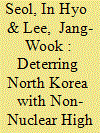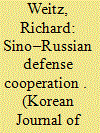|
|
|
Sort Order |
|
|
|
Items / Page
|
|
|
|
|
|
|
| Srl | Item |
| 1 |
ID:
160348


|
|
|
|
|
| Summary/Abstract |
The Republic of Korea (ROK) Ministry of National Defense (MND) should
support and guarantee the process of peaceful and diplomatic denuclearization
by providing a perfect deterrence posture that can cope with any contingencies,
while being especially cautious so as not to ignite political tensions. For that
purpose, strengthening the ROK’s own deterrence capability against the North
Korean military threat is becoming more and more important. This is especially
true because the North Korean ICBM capability, which is assessed to be completed
in a short time, is believed to be able to pose the so-called “decoupling situation”
on the Peninsula, by an increasing number of people. Although it is not certain
the decoupling may really happen even if the North does finally achieve ICBM
capability, this is a problem that cannot be ignored, since more and more people are
worrying about it. Several non-nuclear high-tech weapon systems and masterful
tactics to apply them in the Korean situation raise the possibility of dramatically
strengthening the overall deterrence posture against North Korean threat without
any additional nuclear measures. From now on, the ROK MND should formulate
a new version of the ROK’s own deterrence strategy against the North, the “3K+”
which tries to utilize the new possibilities provided by several conventional hightech
weapons, together with the pre-existing 3K systems (Kill Chain, KAMD, and
KMPR). The new strategy should be built more systematically to overwhelm any
possible North Korean military ambitions in advance, defeating any and all military
capabilities that the North is expected to strive for in the future. As Sun Tzu taught,
the highest strategy can frustrate the enemy into surrendering, even without a fight.
|
|
|
|
|
|
|
|
|
|
|
|
|
|
|
|
| 2 |
ID:
157757


|
|
|
|
|
| Summary/Abstract |
The strengthening Sino–Russian defense partnership has complicated ROK–U.S.
military planning regarding North Korea, diverted U.S. and Japanese resources from
concentrating against North Korea, and worsened the regional security environment
by stimulating local arms races. Beijing and Moscow’s vigorous opposition to the
deployment of advanced U.S. missile defenses in South Korea has illuminated
their perception of increased ROK–U.S. military ties as a potential threat. Further,
China and Russia’s military activities around the Korean Peninsula increase the risk
of inadvertent encounters with other navies. South Korea, Japan, and the United
States need to consider how China and Russia will react in such cases. Additionally,
because the expanding Sino–Russian defense cooperation and technology sharing
complicates assessments of military developments and security trends in Asia, it is
imperative to hold expanded ROK–U.S. consultations, about Sino–Russian defense
interactions, ideally with the inclusion of Japan.
|
|
|
|
|
|
|
|
|
|
|
|
|
|
|
|
|
|
|
|
|